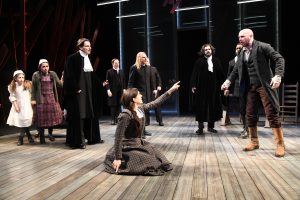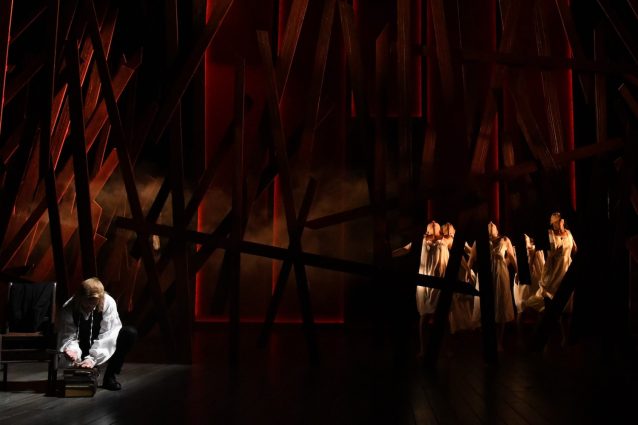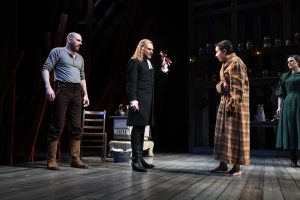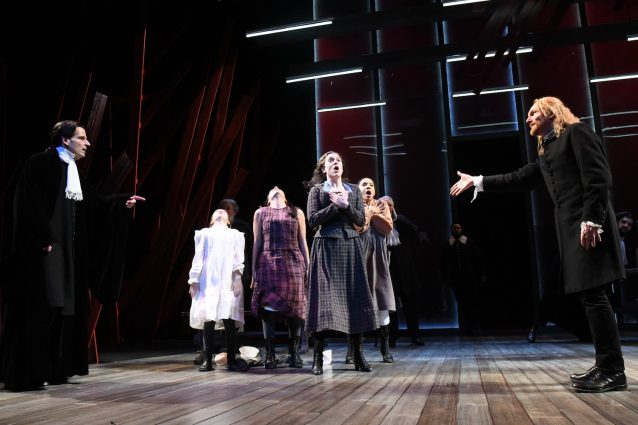This story features “The Crucible” produced by Olney Theatre Center. Learn more about this performance and get tix on the event page.
Once upon a time, there was a witch hunt.
Yes, Olney Theatre Center is “going there,” re-examining Arthur Miller’s “The Crucible”—the brilliantly-written retelling of 17th century crime and punishment that called out 19th century fear-mongering and hypocrisy—in this era of Trumpism, #MeToo and Black Lives Matter. The parallels between then (and then) and now may be plentiful, but director Eleanor Holdridge is determined to stage a modern version of “The Crucible” that is about more than just sex, lies, politics and power.

“Yes, of course, Miller’s writing in response to the HUAC,” said Holdridge, referring to the House Un-American Activities Committee, an offshoot of Congress before which the playwright was forced to appear in 1956. (Miller was blacklisted, jailed and fined for refusing to name names.) “But he’s writing very human characters. No matter what the politics are of the time, these are human people struggling with the larger picture.”
A play written at the height of the anti-Communist fervor known as McCarthyism in 1953 about the 1692 Salem Witch Trials, “The Crucible” takes on new meaning in 2018. The playwright himself admitted to looking for a metaphor and finding that “a living connection between myself and Salem, and between Salem and Washington, was made in my mind.” And yet, its director is looking beyond the easy parallels with today’s headlines to find the universal truth, the modern takeaway.
“We’ll sit there in rehearsals and every once in a while, it just opens up beneath us,” said Holdridge, who compares Miller’s study of fabricated crimes, outrageous punishments and the impact of fear and greed on a flawed society to “a good Shakespeare play. You look at Miller’s characters of Parris and Danforth and Hathorne. It’s a study about how these men made decisions and doubled down on them when questioned, how you can go down a path and find yourself unable to turn from it.
“You make a public statement or an action, and how hard is it to say, ‘I’m wrong.’ Or ‘I made a mistake,’” she added. “That’s any era. That’s human.”
But how does a 21st century production of “The Crucible” underscore the humanity of Miller’s play in our angry, cynical age?
Dance.

“Plays have a narrative, people have a dialogue; we express ourselves in words to one degree or another,” Holdridge said, noting that the idea of the young Puritan girls (and the enslaved Tituba) dancing in the always-encroaching woods is the ever-present counterpoint to the “civilized” men ruling their vulnerable outpost of a town from the pulpit and the courthouse. “But the inexpressible: I want that to be very much alive in this play in terms of the soundscape and the movement—around the edges of the narrative and the scenes.”
The narrative is iconic, and Holdridge refused to change Miller’s “incredible piece of writing.” The poetry of it, she said, is “amazing,” imbued with iambic pentameter that the playwright embedded in some of the most important lines of dialogue. With that in mind, this production fleshes out the character of the dance itself, adding a prologue to define and explain the meaning of the movement by which the women of Salem express themselves. It’s a way of adding a women’s perspective to a time and place where the male gaze is the only point of view.

“It’s a cool idea that Eleanor had, to do this prologue with dance,” said Kelly Crandall d’Amboise, the Florida-born actor-dancer-turned-choreographer who shared the Broadway stage with Hugh Jackman in “The Boy From Oz” before coming to the D.C. area, where she’s on the artistic team at Signature Theatre. “It’s been really fun.”
There’s some “sprinkled, stylized movement throughout” the play, according to d’Amboise, but “the vocabulary is set up in the prologue.” It’s a way to establish the movement language of the group that is at once pivotal and powerless.
“What’s interesting about Eleanor’s idea is that she really wanted to show the side of the girls in their natural state, being wild and bohemian and curious—their adventurous spirit,” she observed. “So, we set up the play and its tone from a different point of view, and that’s kind of cool—to a get a little window into another part of their lives.”
It’s an opportunity to contrast the secret liberated natural state of the women of Salem with their role in a society where most women—considered potential instruments of Satan—could not sign contracts, own property or run a business, and children were legally the property of their fathers.

The prologue, d’Amboise said, shifts the audience back in time, offering a glimpse of what really set the events of “The Crucible” in motion. “It’s natural that you get the flip side of the girls,” she said. “The contrasts are there: They conform to societal standards, but you get this sense of them being sexually curious in a positive way, the sense of them being curious about nature and free of heart.”
Using d’Amboise’s choreography, the actors can set the play’s tone, moving from the wild, carefree dance to the more ominous movements that bring the Puritan society crashing in upon itself. “It’s just different in terms of what we’re showing,” she explained. “It’s from the girls’ point of view.”
Arthur Miller’s “The Crucible” runs through May 20 at Olney Theatre Center, 2001 Olney-Sandy Spring Road, Olney. Performances start at 8 p.m. Wednesday through Saturday; 2 p.m. Saturday and Sunday, and April 25 and May 9. There is no Saturday matinee performance on April 21. There will be an audio-described performance for the blind and visually impaired on at 8 p.m. Wednesday, May 2, and a sign-interpreted performance at 8 p.m. Thursday, May 10. Tickets begin at $47, with discounts available for groups, seniors, military and students. Call 301-924-3400 or visit www.olneytheatre.org.